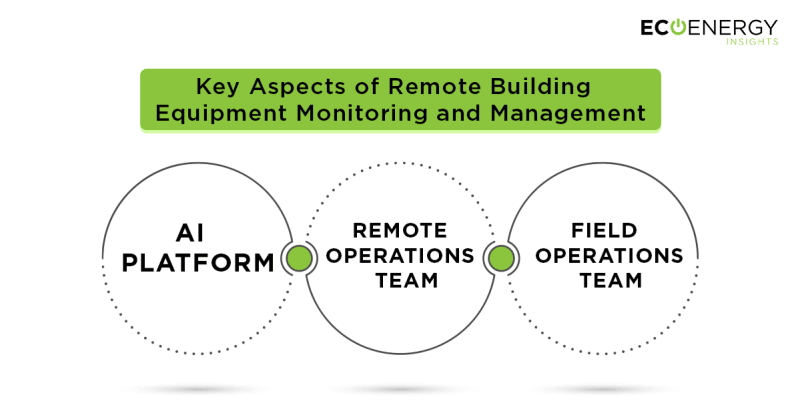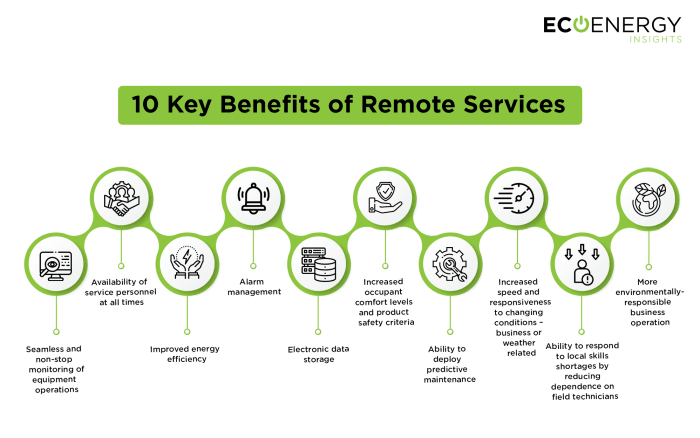
Commercial firms, such as retailers, restaurant operators and retail bankers, rely on building operation. To truly empower employees and engage customers, they must be efficient and create a welcoming indoor environment. Making buildings intelligent can help such firms.
Today, smooth building processes provide a competitive advantage. Artificial Intelligence (AI) and the Internet of Things (IoT) are radically altering the way critical building functions are managed. These technologies aid in the improvement of building efficiency and intelligence, often utilizing data from equipment to improve operations.
However, the true benefit of an AI and IoT solution is reached when the AI’s predictions and recommended actions are followed up on and completed through automation, human influenced remote resolutions, or field activities. And later, the results of the predictions and actions are fed back to make the AI smarter about the insights and actions implemented, improving future accurarcy This will also help track and measure improvements in the overall building operations.
Key aspects of remote building equipment monitoring and management
Businesses are increasingly adopting remote monitoring of their operations, where such services make use of smart equipment and human experience to run them. They use this approach to achieve objectives such as reducing energy expenses while keeping occupants comfortable and merchandise or food, safe. There are three core aspects involved in adopting remote services:

- AI Platform:
The platform is what hosts the artificial intelligence (AI) engine. The success of the platform is dependent on the maturity of the AI engine and the applications built on top of it, as well as the underlying building infrastructure it is connected to. Legacy systems must be scaled up to be able to connect to the cloud, and peripherals such as sensors, meters and controls need to be installed to enable the AI platform to analyze connected equipment performance and offer precise and useful insights. - Remote Operations Team:
This is where human skills, knowledge and experience meet the digital technologies. The team harnesses the power of predictive analytics and connected infrastructure to make changes remotely, coordinate plans to address issues with field teams as well as provide remote support to escalations from stores. The team can also help the AI algorithms evolve and learn from situations. Lastly, the team can help standardize process and replicate the success across other buildings or use cases. - Field Operations Team:
As the name suggests, this is comprised of field technicians. With support from the platform and the remote team, this team can be agile and ensure smooth operations and maintenance of building equipment. The detailed insights into operations from the platform, coupled with expert guidance from the remote team, can enable the field teams to better prioritize actions, reduce troubleshooting time and be more productive. The team can also feed data back into the system regarding whether the diagnosis was correct, what parts were used, etc., to improve the AI platform. Typically, field teams are outsourced, but given that they address multiple customers, empowering them with details to solve your store issues quickly can enable you to optimize contracts with such teams and avoid unnecessary field visits for actions that can be handled remotely.
This model enables remote services, some of which are listed below in three categories, typically deployed for multi-site firms:
- Site Setup Phase
- Remote Commissioning
- Site Operations
- Remote Operations Support
- Schedule Management
- Temperature and Lighting Management
- Alarms Management
- Energy Efficiency Programs
- Remote Operations Support
- Site Maintenance
- Proactive, Preventive & Repair Support
- Maintenance Efficiency Management Programs
Benefits of Remote Services

The fundamental benefit of remote services is that they allow equipment operations to be easily monitored and service personnel to be accessible at all times, even in the most remote areas. Remote services enable businesses to respond quickly to any abnormality or unfavorable trend in a building's performance and to resolve many issues without deploying technicians. When an operator seeks professional help to resolve a problem, remote service teams can anticipate a solution that has been reached following evidence-based study. Even if there are multiple components of equipment from different Original Equipment Manufacturers (OEMs) in the same building, expert remote service teams can provide support for various brands of building equipment. This allows for portfolio-wide monitoring and control of equipment settings, as well as temperature compliance management and energy efficiency improvements.
Remote monitoring offers the advantages of seamless, non-stop monitoring, alarm management, and electronic data storage. Teams can store and later access an infinite amount of information that can be easily sorted and retrieved for analytics or regulatory compliance.
Other benefits of remote services include:
- Improved energy efficiency
- Increased occupant comfort levels and product safety criteria
- Ability to deploy predictive maintenance
- Increased speed and responsiveness to changing conditions – business- or weather-related
- Ability to respond to local skills shortages by reducing dependence on field technicians
The fifth point also has an added benefit that with fewer truck rolling to fix issues at a site, there are reduced associated greenhouse gas emissions leading to more environmentally-responsible business operations.
Deployment of Remote Services
Multi-site businesses that are seeking to deploy remote services need to ascertain the main goals they wish to achieve. This can help decide on the platform and the tools and technologies used by the remote team and the field team for successful deployment of remote services. Because remote operations centers are typically made up of highly skilled personnel supported by cutting-edge technology and operating under strict procedures, being clear on the below considerations can help identify the right team for the business.
- Objective: Is the goal of deploying a remote service any of the following (this can help ensure the services and technology that powers the remote services are suitable).
- Enhancing occupant comfort
- Improving energy efficiency
- Launching predictive maintenance
- TFC considerations:
- Technical – The feasibility of deploying given the business operations and the level of infrastructure at the stores or buildings.
- Functional – The level of remote management necessary to run operations
- Commercial – The capital and overall appetite to fund the launch and operation of remote services and confirming the business case supports deployment.
The ability to anticipate and avert a problem is no longer a luxury, but rather a need. Artificial Intelligence can help with anticipating a problem, but human intelligence and skill is still required for averting a problem.
EcoEnergy Insights’ BluEdge™ Command Centers for Remote Building Operations
New technologies such as AI and IoT are increasingly being applied to all types of buildings, equipment and management systems. With an increase in the amount of data and the ability to control equipment, we can now run operations by making better predictions and planning activities in advance.
The future of building operations lies at the intersection of people skills, digital innovation and robust processes. The BluEdge™ Command Centers of EcoEnergy Insights have teams of data scientists, HVAC, refrigeration, controls and other domain experts. These centers deliver service experiences that are tiered to meet the precise needs of a customer’s business and enable them to meet their objectives. The command centers provide round-the-clock expertise, insights and actions to promote confidence in building and equipment operations, so that they can focus on servicing their customers.
May 2022
Author
Arun Vijay Kumar, Command Center Services at EcoEnergy Insights
Arun is responsible for the design and delivery of Command Center services for EcoEnergy Insights’ services to global customers.